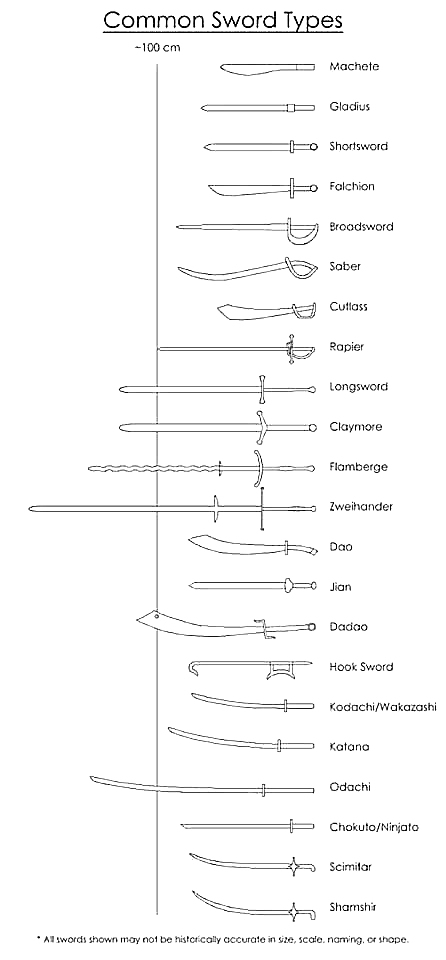
|
- Bayonet: A short to medium length blade adapted to fit the muzzle end of a rifle. The first bayonets were made at Bayonne, France around 1655, and the word "bayonet" or "bayonette" entered the English language around 1672.
- Broadsword: A sword with a wide blade used for slashing and cutting rather than thrusting.
- Claymore: Large heavy Scottish double-edged variant of the late medieval two-handed sword. The Claymore is characterized as having a cross hilt of forward-sloping quillons with quatrefoil terminations. It was in use from the 15th to 17th centuries.
- Cutlass: Heavy short sword with curved single-edged blade used by sailors and pirates
- Dagger: A short stabbing weapon with pointed blade
- Dirk, Durk: Single-edged Scottish dagger with blade about 15 inches (38cm) long
- Epee, épée: Narrow double-edged or triple-edged French sword heavier than a foil with bowl-shaped bell guard used for dueling and fencing, with the opponent's entire body as its target
- Fencing Foil: Narrow four-sided French thrusting weapon with bowl-shaped guard used for fencing, which has as its target the opponent's torso
- Flambergé: Double-edged French sword with wavy multiple-curved or serpentine blade usually over 18 inches in length
- Katana: Japanese single-edged sword with slight curve
- Kris, Kriss: Malaysian double-edged dagger with wavy multiple-curved blade usually under 18 inches in length
- Knights of Columbus: A Masonic ceremonial double-edged sword that dates back to mid to late 1930's with the head of Christopher Columbus, the Order's patron, on the grip cap. The Knights of Columbus sword has a narrow double-edged blade about 28 inches in length with the overall length of the sword in the scabbard being 37 inches. For Masons, the sword is worn hanging from the Service Baldric on the left hip with Columbus' head facing forward.
- Landsknecht Zweihänder: Large two-handed German double-edged sword used by the German Landsknecht in the early 16th century. The Zweihänder swords developed from the bastard sword or montante ("longsword") of the Late Middle Ages, and they became a hallmark weapon of the German Landsknechte from the time of Maximilian (d. 1519) and during the Italian Wars of 1494-1559.
- Light Sword: Shorter version of the classic "knightly" double-edged longsword common to various European cultures dating from the late Medieval period.
- Longsword: Classic "knightly" double-edged sword common to various European cultures dating from the late Medieval period.
- Rapier: A long narrow French sword lacking a cutting edge, often with swept, basket or cuplike hilt, used in the 16th and 17th centuries for thrusting
- Saber, Sabre: Single-edged military sword with slight curve and swept knuckle guard
- Sai: Far-eastern style eight-sided sword used for martial arts practice
- Scimitar: Near-eastern style single-edged curved saber
- Shamshir: Type of sabre with a curve that is considered radical for a sword: 5 to 15 degrees from tip to tip. The name is derived from Persian
 "shamshir", which means "sword" (in general). Typical pre-Islamic Iranian blades used for warfare were originally straight. Curved blades in this period were used primarily for hunting, though examples of curved swords used in battle are present in Greek depictions of Achaemenid Persian soldiers. The curved scimitar blades became popular after the Mongol invasions. The sword now called shamshir was popular in Persia by the early 16th century, with similar variations in Turkey (the kilij), Mughal India (the talwar), and the adjoining Arabian world (the saif). These blades all were developed from the ubiquitous parent sword, the Turko-Mongol saber. "shamshir", which means "sword" (in general). Typical pre-Islamic Iranian blades used for warfare were originally straight. Curved blades in this period were used primarily for hunting, though examples of curved swords used in battle are present in Greek depictions of Achaemenid Persian soldiers. The curved scimitar blades became popular after the Mongol invasions. The sword now called shamshir was popular in Persia by the early 16th century, with similar variations in Turkey (the kilij), Mughal India (the talwar), and the adjoining Arabian world (the saif). These blades all were developed from the ubiquitous parent sword, the Turko-Mongol saber.
- Stiletto: Smaller version of the Italian 'stilo' dagger with a double-edged almost triangular blade which was easy to hide in clothing
- Wakizashi: Small Japanese single-edged katana sword
- Zweihänder: Large two-handed German double-edged sword used primarily in the early 16th century. The Zweihänder swords developed from the bastard sword or montante ("longsword") of the Late Middle Ages. They became a hallmark weapon of the German Landsknechte from the time of Maximilian (d. 1519) and during the Italian Wars of 1494-1559.
|




